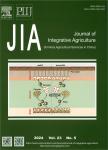Causes of maize density loss in farmers’ fields in Northeast China
Causes of maize density loss in farmers’ fields in Northeast China作者机构:Key Laboratory of Plant-Soil Interactions Ministry of Education Beijing 100193 P.R.China College of Resources and Environmental Sciences China Agricultural University Beijing 100193 P.R.China College of Resources and Environmental Science Hebei Agricultural University Baoding 071001 P.R.China
出 版 物:《Journal of Integrative Agriculture》 (农业科学学报(英文版))
年 卷 期:2019年第18卷第8期
页 面:1680-1689页
核心收录:
学科分类:0710[理学-生物学] 0832[工学-食品科学与工程(可授工学、农学学位)] 0830[工学-环境科学与工程(可授工学、理学、农学学位)] 1004[医学-公共卫生与预防医学(可授医学、理学学位)] 0905[农学-畜牧学] 0906[农学-兽医学] 09[农学] 0901[农学-作物学] 0703[理学-化学] 0902[农学-园艺学] 0713[理学-生态学]
基 金:financially supported by the National Basic Research Program of China (2015CB150405)
主 题:plant density maize production density loss density gap farmers’ fields
摘 要:Increasing plant density is an effective and important way to reduce maize yield gaps in Northeast China. However, the fact is that a significant plant density gap exists between optimum plant density and actual plant density in farmers’ *** quantify the density gap between planned planting density and final harvest plant density(HPD), we studied 60 farmers’ fields on three types of soil for three crop seasons from 2015 to 2017 by measuring their plant-plant distance, actual seedlings density(ASD), final HPD and yield. We also explored the potential causes of density loss by digging the places where the seedlings were missing for two consecutive years in 2016–2017. Results show that the three-year average HPD in farmers’ fields was 59 699 plants ha^–1, which was significantly lower than the planned density, including both the machine setting density(MSD;67 962 plants ha^–1) and theoretical plant density(TPD;67 467 plants ha^–1). No significant difference was found in HPD between years and soil types. However, for MSD and TPD, the average value in 2015 was significantly higher than that in 2016 and 2017. No significant difference between soil types was observed. Furthermore,the results from 2016 till 2017 indicated that a lack of seeds in the soil, a failure to germinate due to low-quality seeds,and a lack of seedlings breaking out of the soil due to environmental problems explained approximately 60.88, 10.33 and 28.80% of density loss, respectively. According to our survey, 63% of farmers did not know their own TPD and HPD, and 54% of farmers did not know the density loss. Therefore, we argue that farmers’ limited knowledge of density and density loss is an urgent problem that needs to be solved in maize production. These observations will be useful for determining best management practices for maize production and for providing helpful suggestions for machine improvement.



